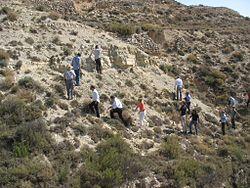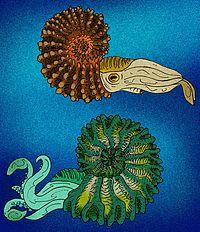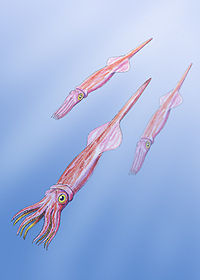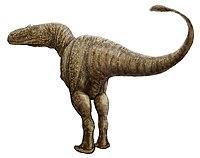| Aalenian | |
|---|---|
| 174.1 ± 1.0 – 170.3 ± 1.4 Ma | |
 The Aalenian GSSP in Spain | |
| Chronology | |
Key events in the Jurassic -200 — – -195 — – -190 — – -185 — – -180 — – -175 — – -170 — – -165 — – -160 — – -155 — – -150 — – -145 — – how to approximate the timescale of key Jurassic events. Vertical axis: millions of years ago. | |
| Etymology | |
| Name formality | Formal |
| Usage information | |
| Celestial body | Earth |
| Regional usage | Global (ICS) |
| Time scale(s) used | ICS Time Scale |
| Definition | |
| Chronological unit | Age |
| Stratigraphic unit | Stage |
| Time span formality | Formal |
| Lower boundary definition | FAD of Ammonites Leioceras opalinum and Leioceras lineatum |
| Lower boundary GSSP | Fuentelsaz, Spain 41°10′15″N 1°50′00″W / 41.1708°N 1.8333°W |
| GSSP ratified | 2000[1] |
| Upper boundary definition | FAD of the Ammonites Hyperlioceras mundum, Hyperlioceras furcatum, Braunsina aspera, and Braunsina elegantula |
| Upper boundary GSSP | Cabo Mondego, Portugal 40°11′57″N 8°54′15″W / 40.1992°N 8.9042°W |
| GSSP ratified | 1996[2] |
The Aalenian ( /ɑːˈliːniən/) is a subdivision of the Middle Jurassic epoch/series of the geologic timescale that extends from about 174.1 Ma to about 170.3 Ma (million years ago). It was preceded by the Toarcian and succeeded by the Bajocian.[3]
Stratigraphic definitions
The Aalenian takes its name from the town of Aalen, some 70 km east of Stuttgart in Germany. The town lies at the northeastern end of the Swabian Jura. The name Aalenian was introduced in scientific literature by Swiss geologist Karl Mayer-Eymar in 1864.
The base of the Aalenian is defined as the place in the stratigraphic column where the ammonite genus Leioceras first appears. The global reference profile (GSSP) is located 500 meters north of the village of Fuentelsaz in the Spanish province of Guadalajara.[4] The top of the Aalenian (the base of the Bajocian) is at the first appearance of ammonite genus Hyperlioceras.
In the Tethys domain, the Aalenian contains four ammonite biozones:
- zone of Graphoceras concavum
- zone of Brasilia bradfordensis
- zone of Ludwigia murchisonae
- zone of Leioceras opalinum
Palaeontology
†Ammonitids
| †Ammonitids of the Aalenian | ||||
|---|---|---|---|---|
| Taxa | Presence | Location | Description | Images |
| Confirmed.[5] | The only known species in this Alaskan genus. Abbasites is believed to be ancestral to the ammonite family Otoitidae. | ||
| Confirmed.[5] | ||||
| Confirmed.[5] | ||||
| Confirmed.[5] | |||
| Confirmed.[5] | |||
| Confirmed.[5] | |||
| Confirmed.[5] | |||
| Confirmed.[5] | |||
| Confirmed.[5] | |||
| Confirmed.[5] | |||
| Confirmed.[5] | |||
| Confirmed.[5] | |||
| Confirmed.[5] | |||
| Confirmed.[5] | |||
| Confirmed.[5] | |||
| Confirmed.[5] | |||
| Confirmed.[5] | |||
| Confirmed.[5] | |||
| Confirmed.[5] | |||
| Confirmed.[5] | |||
| Confirmed.[5] | |||
| Confirmed.[5] | |||
| Confirmed.[5] | |||
| Confirmed.[5] | |||
| Confirmed.[5] | |||
| Confirmed.[5] | |||
| Confirmed.[5] | |||
| Confirmed.[5] | |||
| Confirmed.[5] | |||
| Confirmed.[5] | ||||
| Confirmed.[5] | |||
| Confirmed.[5] | |||
†Belemnites
| Belemnites of the Aalenian | ||||
|---|---|---|---|---|
| Taxa | Presence | Location | Description | Images |
| Confirmed.[5] | |||
| Confirmed.[5] | |||
| Confirmed.[5] | |||
| Confirmed.[5] | This Eurasian species was the largest known Belemnite and could grow to lengths of up to 10 feet (3.0 m). | ||
| Confirmed.[5] | |||
| Confirmed.[5] | |||
| Confirmed.[5] | |||
Bony fish
| Bony fish of the Albian | ||||
|---|---|---|---|---|
| Taxa | Presence | Location | Description | Images |
| Pliensbachian-Aalenian | Europe (France, Belgium, Luxembourg, United Kingdom, Germany, Italy) and North America (Canada) | A saurichthyiid actinopterygian. | |
Ichthyosaurs
| Ichthyosaurs of the Toarcian | ||||
|---|---|---|---|---|
| Taxa | Presence | Location | Description | Images |
| Europe | ||||
†Thalattosuchians
| Thalattosuchia of the Aalenian | ||||
|---|---|---|---|---|
| Taxa | Presence | Location | Description | Images |
| Germany | A basal metriorhynchoid. | ||
Dinosaurs
Sauropods
| Sauropods of the Aalenian | ||||
|---|---|---|---|---|
| Taxa | Presence | Location | Description | Images |
| "Bothriospondylus" madagascariensis | possibly a new genus | |||
Theropods
| Theropods of the Aalenian | ||||
|---|---|---|---|---|
| Taxa | Presence | Location | Description | Images |
| Asfaltovenator | Toarcian-Bajocian | Cañadón Asfalto Basin, Patagonia, Argentina | A large basal carnosaur. The unique combination of characteristics seen in Asfaltovenator may indicate megalosauroids and allosauroids shared a common ancestor not shared with Coelurosauria. | |
| Aalenian-Bajocian | Cañadón Asfalto Basin, Patagonia, Argentina | It was among the earliest large South American theropods. | ||
| Aalenian-Bajocian | Dorset, England | Magnosaurus was one of the first megalosaurids to evolve. | ||
| Shidaisaurus | Early Aalenian | Chuanjie Formation, Yunnan, China | A genus of early medium sized metriacanthosaurine allosauroid, estimated from around 6 to over 7 meters long and from 700 up to 950 kilograms in mass. | |
References
Notes
- ^ Cresta, S.; Goy, A.; Arias, C.; Barrón, E.; Bernad, J.; Canales, M.; García-Joral, F.; García-Romero, E; Gialanella, P.; Gómez, J.; González, J.; Herrero, C.; Martínez2, G.; Osete, M.; Perilli, N.; Villalaín, J. (September 2001). "The Global Boundary Stratotype Section and Point (GSSP) of the Toarcian-Aalenian Boundary (Lower-Middle Jurassic)" (PDF). Episodes. 24: 166–175. Retrieved 13 December 2020.
- ^ Pavia, G.; Enay, R. (March 1997). "Definition of the Aalenian-Bajocian Stage boundary". Episodes. 20 (1): 16–22. doi:10.18814/epiiugs/1997/v20i1/004. Retrieved 23 December 2020.
- ^ See Gradstein et al. (2004) for a detailed version of the geologic timescale
- ^ Cresta et al. (2001)
- ^ a b c d e f g h i j k l m n o p q r s t u v w x y z aa ab ac ad ae af ag ah ai aj ak al am Sepkoski (2002)
Literature
- Gradstein, F.M.; Ogg, J.G. & Smith, A.G.; 2004: A Geologic Time Scale 2004, Cambridge University Press.
- Cresta, S.; Goy, A.; Ureta, S.; Arias, C.; Barrón, E.; Bernad, J.; Canales, M.L.; García-Joral, F.; García-Romero, E.; Gialanella, P.R.; Gómez, J.J.; González, J.A.; Herrero, C.; Martínez, G.; Osete, M.L.; Perilli, N. & Villalaín, J.J.; 2001: The Global Boundary Stratotype Section and Point (GSSP) of the Toarcian-Aalenian Boundary (Lower-Middle Jurassic), Episodes 24(3): pp 166–175.
- Mayer-Eymar, K.; 1864: Tableau synchronistique des terrains jurassiques. 1 Tabelle, Zürich. (in French)
- Sepkoski, J.; 2002: A compendium of fossil marine animal genera (entry on cephalopoda), Bulletins of American Paleontology 364, p 560.
External links
- GeoWhen Database - Aalenian
- Lower Jurassic timescale, at the website of the subcommission for stratigraphic information of the ICS
- Stratigraphic chart of the Upper and Lower Jurassic, at the website of Norges Network of offshore records of geology and stratigraphy



